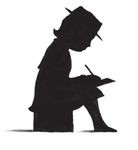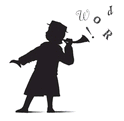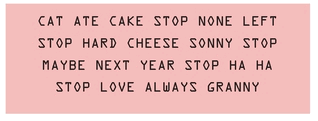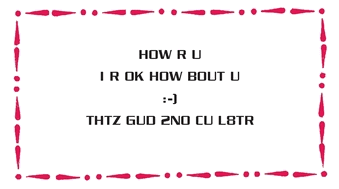The Word Snoop (19 page)
Authors: Ursula Dubosarsky

Answers
SPOONERISMS
1.
It’s pouring rain outside.
It’s pouring rain outside.
2.
That’s a pack of lies!
That’s a pack of lies!
3.
Would you like a bowl of salad?
Would you like a bowl of salad?
4.
I don’t have time to do my chores.
I don’t have time to do my chores.
5.
Do you live on this block of houses?
Do you live on this block of houses?
6.
Bye all!
Bye all!
MALAPROPISMS
1.
An ambidextrous person can write with both hands.
An ambidextrous person can write with both hands.
2.
Stop being such an idiot!
Stop being such an idiot!
3.
She was rushed to the hospital with a bad case of pneumonia.
She was rushed to the hospital with a bad case of pneumonia.
4.
The old man with gray hair looked very distinguished.
The old man with gray hair looked very distinguished.
Dear Snoops,
We are now coming to the end of
this book (phew!) and (sob!).
this book (phew!) and (sob!).
By now you will have noticed that many of the
words we’ve been snooping on together are very
old
—
even thousands of years old. But this last
adventure into the world of texting and Internet
languages is far newer
—
or is it?
words we’ve been snooping on together are very
old
—
even thousands of years old. But this last
adventure into the world of texting and Internet
languages is far newer
—
or is it?
Probably by the time this book is published,
some of the things I’m going to write about here
will no longer be true. That’s how it is with
words. As soon as you think you understand
what’s going on, it all changes. Words jump and
run and cartwheel around like a gang of spider
monkeys. You can hardly keep your eye on one
before another one is leaping around and doing
something different altogether.
some of the things I’m going to write about here
will no longer be true. That’s how it is with
words. As soon as you think you understand
what’s going on, it all changes. Words jump and
run and cartwheel around like a gang of spider
monkeys. You can hardly keep your eye on one
before another one is leaping around and doing
something different altogether.
But U kp rdn itz bn gr8!
Da Werd Snewp
Da Werd Snewp

10.
Back to the future
TelegrameseF
irst, to go back in time . . .
irst, to go back in time . . .
I know, I know—I said this was going to be about new things. But there’s just a little bit of history to begin with.
Many years ago (like more than 100), there were no such things as texts or e-mail or even the telephone. If you wanted to send someone far away a short message very fast, you had to put a letter in an empty bottle and throw it in the ocean . . .
Ha ha! Only joking. :-)
I’ll start that again. If you wanted to send someone far away a short message very fast
electronically,
you had to use something called a telegram
.
This was usually done at the post office. You would tell the person at the post office what you wanted to say and they would type it into a machine, which would send the message electronically to another post office anywhere in the world.
electronically,
you had to use something called a telegram
.
This was usually done at the post office. You would tell the person at the post office what you wanted to say and they would type it into a machine, which would send the message electronically to another post office anywhere in the world.
Now, in a telegram you paid for each word, so to save money you used as few words as possible. As a result, a very short way of saying things developed, known as telegramese. In some ways it was like the brief writing we use in mobile phone text messages today. Have a look at this telegram that the Word Snoop’s great-grandmother received on her 113th birthday, from her favorite grandson, Alyosha:


Just like in a text message, you can see that Alyosha tried to keep the message short by leaving out words he might have put in if he’d been writing a letter. You can also see that, unlike text messages, telegrams were printed in CAPITAL LETTERS, which meant it looked like you were SHOUTING, and the word STOP was used for a period. You could include other punctuation if you wanted to, but a single mark cost the same as a single word, so people rarely did.
Okay, so both telegrams and text messages are short, but the big difference between the two is that millions of texts are sent around the world every day, whereas telegrams were mainly kept for special occasions. This meant that unlike the ever-changing, ever-developing language of texting, telegramese remained pretty much the same.
It’s funny—even though nowadays with the Internet and mobile phones there’s no real need for telegrams anymore, people still seem to like them and you can still send a telegram from the post office if you want to.
Or a gorillagram if you
really
want to . . .
really
want to . . .

Singing telegrams
When telegrams began 100 years ago, they were mainly used to communicate bad news
—
that is, to say that someone was sick or had died. So when the telegram boy arrived at the door, most people thought “Uh-oh.” To encourage people to think of telegrams as happy things, singing telegrams were invented in the 1930s. A delivery boy would come to your door and sing a message, usually for someone’s birthday or a wedding.
—
that is, to say that someone was sick or had died. So when the telegram boy arrived at the door, most people thought “Uh-oh.” To encourage people to think of telegrams as happy things, singing telegrams were invented in the 1930s. A delivery boy would come to your door and sing a message, usually for someone’s birthday or a wedding.
It must have been quite hard sometimes. Try singing this telegram that Alyosha got back in reply from my great-grandmother:



Can you read this? If you send a lot of text messages through your mobile phone, I’m sure you can. If not, it probably looks pretty peculiar. Many people (well, let’s face it, adults) look at text messages and think: “Hey, these kids don’t know how to spell or write.” But it’s a lot more inventive than that.
The words in text messages have a lot in common with the words you find in Internet slang and Internet languages, like LOL (Laugh Out Loud) or Leet, or other ways people communicate through the computer or game consoles. Although it seems very new and modern, quite a lot of the tricks of this sort of writing have actually been around for years—centuries, even. Have a look for yourself:
* leaving out vowels (a, e, i, o, u), like
bn
for “been” or
fst
for “fast.” Well, remember originally the alphabet had no vowels.
bn
for “been” or
fst
for “fast.” Well, remember originally the alphabet had no vowels.
* changed or shortened spelling, usually so the word is written as it’s spoken, like
cud
for “could” or
vzt
for “visit.” People have been wanting to change spelling like this for ages.
cud
for “could” or
vzt
for “visit.” People have been wanting to change spelling like this for ages.
* using little punctuation and few capital letters, like
wnt 2 go 4 pza
. Well, in the beginning English didn’t use either of these things anyway.
wnt 2 go 4 pza
. Well, in the beginning English didn’t use either of these things anyway.
* using numbers or letters that sound like words instead of the word itself. So
B4
for “before” or
L8
for “late,”
CU
for “see you.” That’s something as old as the hills—remember the rebus?
B4
for “before” or
L8
for “late,”
CU
for “see you.” That’s something as old as the hills—remember the rebus?
* acronyms, like
ttyl
for “talk to you later” or
bff
for “best friends forever.” Even the ancient Romans used acronyms.
ttyl
for “talk to you later” or
bff
for “best friends forever.” Even the ancient Romans used acronyms.
* clipping words, either at the beginning, like
lo
for “hello,” or at the end, like
rad
for “radical.” We all use plenty of words like this already—just think of
bus
for “omnibus” or
pop
for “popular.”
lo
for “hello,” or at the end, like
rad
for “radical.” We all use plenty of words like this already—just think of
bus
for “omnibus” or
pop
for “popular.”
* deliberate mistakes, like changing the grammar to make the text shorter, like
i r
for “I am”; or typing “own” as
pwn
on purpose, instead of by accident.
i r
for “I am”; or typing “own” as
pwn
on purpose, instead of by accident.
So as you can see, it’s the technology, the
way
the messages are sent, rather than the language that makes it so new. But it has given rise to some new forms of writing. Text poetry, for example. After all, the shortness of text messages calls for very concentrated ideas and images, rather like the traditional Haiku poetry of Japan. Works of Shakespeare and Dickens and even the Lord’s Prayer have all been turned into text language. And now novels written entirely in instant messaging have started to appear, such as
ttyl
and
ttfn
by Lauren Myracle—maybe you can find them in the library. Or why not try writing a text story or poem yourself?
way
the messages are sent, rather than the language that makes it so new. But it has given rise to some new forms of writing. Text poetry, for example. After all, the shortness of text messages calls for very concentrated ideas and images, rather like the traditional Haiku poetry of Japan. Works of Shakespeare and Dickens and even the Lord’s Prayer have all been turned into text language. And now novels written entirely in instant messaging have started to appear, such as
ttyl
and
ttfn
by Lauren Myracle—maybe you can find them in the library. Or why not try writing a text story or poem yourself?
In the meantime, can you work out what popular folk song the Word Snoop has “translated” into text?
Twinkle, twinkle ltl (*),
how I 1Dr wot UR. ^ abof d wrld so hI,
lIk a diamond n d sky.
Twinkle, twinkle ltl (*),
how I 1Dr wot U R.
how I 1Dr wot UR. ^ abof d wrld so hI,
lIk a diamond n d sky.
Twinkle, twinkle ltl (*),
how I 1Dr wot U R.
I’m sad to say we’re almost at the end of this book. But I’m glad to say we’re finishing with something happy—smileys. (See, you’re smiling already!)
A smiley is a symbol you create by using the punctuation marks on the keyboard to make messages without words. The most common is the happy face (“smiley,” get it?) made up of a colon and a bracket. It looks like eyes and a smiling mouth if you turn your head sideways (don’t hurt your neck . . .).

Other books
Poseur by Compai
Foreplay: A Succubus Diaries Prequel by Jill Myles
The Laws of Gravity by Liz Rosenberg
Breaking Brooklyn by Scott Leopold
Magic and Decay by Rachel Higginson
Grand Avenue by Joy Fielding
Can't Go Home (Oasis Waterfall) by Stone, Angelisa Denise
Goodnight Lady by Martina Cole
California Dreaming by Zoey Dean
Taste of Passion by Jones, Renae
